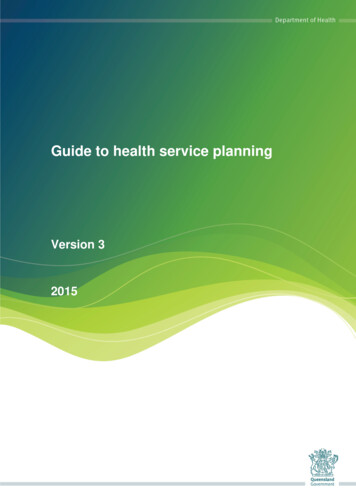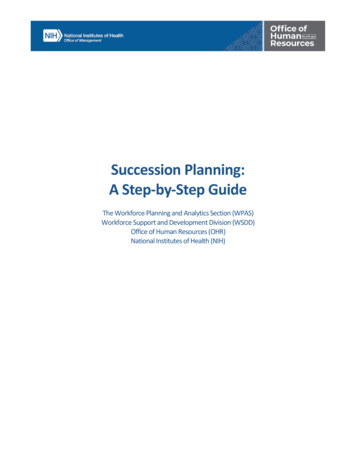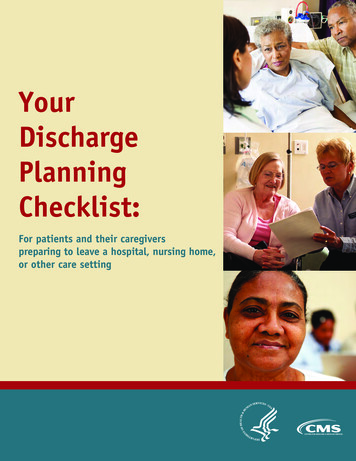
Transcription
Guide to health service planningVersion 32015
Guide to health service planning (version 3)Published by the State of Queensland (Queensland Health), June 2015This document is licensed under a Creative Commons Attribution 3.0 Australia licence.To view a copy of this licence, visit creativecommons.org/licenses/by/3.0/au State of Queensland (Queensland Health) 2015You are free to copy, communicate and adapt the work, as long as you attribute theState of Queensland (Queensland Health).For more information contact:Service Needs, Access and Planning Branch, Health Commissioning Queensland,Department of Health, GPO Box 48, Brisbane QLD 4001An electronic version of this document is available at www.health.qld.gov.auDisclaimer:The content presented in this publication is distributed by the Queensland Government as an information source only.The State of Queensland makes no statements, representations or warranties about the accuracy, completeness orreliability of any information contained in this publication. The State of Queensland disclaims all responsibility and allliability (including without limitation for liability in negligence) for all expenses, losses, damages and costs you mightincur as a result of the information being inaccurate or incomplete in any way, and for any reason reliance was placedon such information.Guide to health service planning (version 3)- ii -
Contents1.Introduction . 41.11.21.32.Queensland context . 72.12.22.32.42.53.Scope the planning activity . 18Understand the population and service environment . 19Identify the health service needs. 22Prioritise the health service needs . 23Identify the health service directions . 24Develop/analyse service options. 25Develop objectives and strategies . 26Implementation and review phase explored . 286.16.26.37.Planning and implementation cycle. 15Planning phase . 16Implementation and review phase . 16Processes across the cycle . 17Planning phase explored . 185.15.25.35.45.55.65.76.Three main types of planning . 12‘Integrating’ planning in the health system . 12Considering service enablers in planning. 13Health service planning process . 154.14.24.34.45.Health policy . 7Health need . 8Health services . 9Health service planning responsibilities . 9Health service planning principles. 11Types of health service planning. 123.13.23.34.Purpose of this guide . 4What is health service planning? . 4Importance of health service planning . 5Conclude the planning phase . 28Conduct additional planning to support implementation . 29Monitor, evaluate and review . 30Processes across the cycle explored . 327.17.27.3Governance and leadership . 32Project management. 32Communication and consultation . 33Appendices. 35Glossary . 39References . 42Guide to health service planning (version 3)- iii -
1.Introduction1.1Purpose of this guidePlanning health services is complex. It requires a rigorous, evidence based approachto improving services to meet the future health needs of the population.The Guide to health service planning (the guide) details the theoretical framework forhealth service planning in Queensland. It provides an understanding of what healthservice planning is; the core components of the process; and what factors need to beconsidered when undertaking this type of planning.The guide is primarily intended as a resource for the Queensland Department of Healthand the Hospital and Health Services (HHS) in the context of planning for public sectorhealth services in Queensland. While the focus of the guide is on public sector healthservices, planning should always consider the broader health system context.The guide is not intended to provide a step-by-step manual for planning. For moredetailed guidance and support, there are several resources available on the healthservice planning page of the Queensland Health Electronic Publishing Service(QHEPS). Among these resources are two supplements to the guide: Health information supplement Implementation supplement.1.2What is health service planning?Planning can be defined as where one wants to go, how to get there and the timetable for thejourney Complete planning sets out indicators for tracking progress andways to measure if the trip was worth the investment. 1Central to most definitions of planning is the concept of making decisions that reflectand address future needs. 2 Therefore, planning involves specifying future goals andthen setting courses of action to achieve these. 3In the context of public sector health service delivery, planning is primarily concernedwith developing and supporting a health system that delivers high quality services tothe community. 4Health service planning specifically aims to improve the health status of a given population while safeguarding equity andfairness of access as well as responsiveness of the health system to theperceived needs of the community. [Health service planning] shouldachieve this goal through the provision of efficient and effective healthservices, taking into account available resources and the available meansand methods of health care.3Guide to health service planning (version 3)-4-
Thus, health service planning involves the process of aligning existing health servicedelivery arrangements with changing patterns of need, to make the most effective useof available and future resources. 5Central to most definitions of health service planning is the concept of extending thepolicy and strategic directions of a healthcare organisation into meaningful serviceprovision. This is achieved through a comprehensive and transparent process ofdefining service objectives and strategies to meet the objectives.2,6Health service planning is one of several types of planning that health organisationsundertake. Other types include strategic, operational, budgetary, service enabler(including assets, clinical support services, funding, information and communicationtechnology and workforce) and individual performance planning.4Health service planning is future oriented. Compared with many of the other types ofplanning (noted above), it usually adopts a longer term (10 years) perspective. Thisapproach supports organisations to be better prepared to address emerging healthtrends and other factors that are central to contemporary healthcare. Some of thesefactors are detailed in Section 1.3.1.3Importance of health service planningDelivery of health services occurs in an increasingly dynamic environment with everchanging community expectations, government priorities and technological advances.Health budgets are constrained, yet there are ever-increasing pressures and demandson the public sector health system.1 Much of the pressure on future health systems willresult from the ageing of the population and the increasing prevalence of chronicdiseases. 7In this context, it is essential that services are well planned and have the capability torespond to evolving changes in order to meet community needs.Changing populations and population needsAssessing population characteristics (e.g. growth, age groupings, cultural diversity andsocioeconomic status) and anticipated changes in these will guide the most appropriateservice response. Similarly, by identifying population risk factors (e.g. obesity, smokingand excessive alcohol consumption) that contribute to various health issues, servicescan be designed to reduce these risks for targeted population groups.Emerging clinical evidence and technologiesUnderstanding and assessing the potential impacts of advances in clinical evidenceand technologies helps inform the way future services need to be organised anddelivered. This includes being aware of changes in the knowledge and understandingof diseases and disease trends, treatment techniques and service delivery models.Projecting future service needUnderstanding future demand for services—influenced by changes in populations,disease patterns and treatment technologies (all noted above)—is an importantelement of health service planning. By assessing how demand may grow or decline,decisions about future service developments are better informed.Guide to health service planning (version 3)-5-
Prioritising allocation of resourcesThe resources available to invest in health services are limited. Health service planningcan identify health service resources required to meet health needs. The prioritisationof health needs and service issues identified through a rigorous health service planningprocess will support resources being directed towards the areas of greatest need.Improving service efficiencyHealth service planning explores alternative service options that can optimise servicedelivery arrangements to manage increasing demand. Advances in treatment optionsand in the delivery of services in a range of settings (e.g. hospital in the home) allow forsubstantial flexibility in health service delivery in the future.Providing safe and sustainable servicesHealth services must be capable of sustaining the provision of high quality care thatcontinues to meet (or exceed) required minimum standards. Health service planningconsiders issues of service viability when planning future services.How planning is important to safe and sustainable service deliveryIn Queensland, health services are delivered in line with the Clinical services capabilityframework for public and licensed private health facilities. 8The framework provides minimum requirements for health services, support services,staffing and safety standards to ensure the provision of safe and appropriately supportedservices.The framework is also an important tool for health service planners to use in planning futureservices that are safe and sustainable. It: provides a standard set of capability requirements for most acute and sub-acute services provides a consistent language for health service providers and planners to use encourages explicit clinical risk management procedures where services do not meetminimum patient safety requirements articulates credentialing, privileging, qualification and training requirements identifies the relationships and interdependencies between health services.Health service planning can help services respond to many of these changing elementsof the healthcare landscape. As such, one of the strengths of planning is in itsapplication as a change agent.Planning can explore and challenge the status quo of service delivery. It provides aplatform for examining the evidence for services being delivered in a particular way orto meet a particular need. Therefore, it can help to assess and challenge models ofcare or service delivery models that are inconsistent with the evidence. It can alsochallenge service delivery that, on the available evidence, does not meet current oranticipated health needs.Guide to health service planning (version 3)-6-
2.Queensland context2.1Health policyAustralian and Queensland Government policy directions and priority areas provide theframework for delivering health services in Queensland. In Queensland, the legislationthat governs public sector health services is the Hospital and Health Boards Act 2011. 9The Act exists: to establish a public sector health system that delivers high qualityhospital and other health services to persons in Queensland having regardto the principles and objectives of the national health system.9The Act states this aim will be achieved primarily through three processes: strengthening local decision-making and accountability, local consumer andcommunity engagement and local clinician engagement providing for statewide health system management including health systemplanning, coordination and standard setting balancing the benefits of the local and system-wide approaches.9Health service planning has an important relationship to legislation, policy, and to othertypes of planning. All health service planning activities (regardless of context) shouldalign with relevant Australian and Queensland Government policy as well as strategicplanning associated with these policy directions and priorities.Similarly, the recommendations that stem from a health service planning activity maybe translated into subsequent planning that has a more operational focus. These caninclude operational planning, service enabler planning and individual performanceplanning.Relationship between policy and planningPolicy and planning are closely linked but not interchangeable.A ‘policy’ is a statement of intent in relation to providing a service, managing an operationalor governance issue or addressing a problem. 10Health service planning focuses on what should be done to achieve the direction specifiedby a relevant policy or strategic plan.1Through a process of analysis, health service planning identifies the changes required in aparticular area and develops strategies to achieve these changes.Because policy can cover matters ranging from high-order strategy to administrative detail,specifying the link between policy and planning is important.Guide to health service planning (version 3)-7-
2.2Health need‘Health need’ refers to a deficiency in health that requires health care. Health need canbe subjectively determined (as perceived by an individual) or objectively determined(as defined by a health professional or through scientific confirmation).For the purposes of this guide, health needs of the Queensland population arerepresented as categories on a continuum extending from the well population to thoseat the end of life, as illustrated in Figure ntification& interventionAcuteconsequences& conditionsChronicconsequences& conditionsEnd of lifeDescriptionPeople whoare generallyhealthy andable to liveindependentlivesPeople with aprobability ofdeveloping ahealthcondition or anadverse healthoutcome, or afactor thatraises thisprobabilityPeopleexperiencingearly effects ofill health andwho, withoutintervention,may progressto acute orchronicconsequencesFigure 1People thatrequiretreatmentPeople withconditionsthat arepersistent andlong lastingand/or leaveresidualdisabilityPeople withfatalconditions andthose who aredyingHealth need continuumThe value of identifying categories of health need in a population along a continuumlies in promoting the principle of continuity of care. The continuum is not representativeof a linear process; it is intended to represent stages of health need for people whichmay arise over time and at various stages of life and disability.Healthcare requirements at any point along the continuum may involve a wide range ofservices, providers and settings. Effective health service planning provides cleardirection for service development and resource investment across all areas of thehealth system.Regardless of the scope of the planning, the entirety of this continuum should beconsidered. Doing this ensures the complexity of managing a health condition acrossdifferent service settings and providers are considered. However, depending on thetype of planning being undertaken, the focus may be on a specific area of thecontinuum (refer Section 3 for types of health service planning).Guide to health service planning (version 3)-8-
2.3Health servicesHealth services aimed at meeting the health needs of the Queensland population arearranged in a complex configuration. Healthcare provision occurs across several levelsof government as well as the non-government sector (including for-profit and not-forprofit agencies). The responsibility for policy, funding and service provision variesacross providers and the relationships between providers can also be complex.The current (2012) National Healthcare Agreement affirms the commitment made of allgovernments (Australian, state and territory) that services delivered through Australia'shealth system should: be shaped around the health needs of individual patients, their families andcommunities focus on the prevention of disease and injury and the maintenance of health, notsimply the treatment of illness support an integrated approach to the promotion of healthy lifestyles, prevention ofillness and injury, and diagnosis and treatment of illness across the continuum ofcare provide all Australians with timely access to quality health services based on theirneeds, not ability to pay, regardless of where they live in the country. 11The agreement also contains seven expected outcomes of health services andsystems:1.Australians are born and remain healthy.2.Australians receive appropriate high quality and affordable primary andcommunity health services.3.Australians receive appropriate high quality and affordable hospital and hospitalrelated care.4.Older Australians receive appropriate high quality and affordable health and agedcare services.5.Australians have positive health and aged care experiences which take accountof individual circumstances and care needs.6.Australians have a health system that promotes social inclusion and reducesdisadvantage, especially for Indigenous Australians.7.Australians have a sustainable health system.11In Queensland, the Hospital and Health Boards Act 2011 re-affirms the principles andexpected outcomes of the health system as set out in the National HealthcareAgreement.92.4Health service planning responsibilitiesThe Hospital and Health Boards Act 2011 and the associated Hospital and HealthBoards Regulation 2012 articulate the responsibilities for health service planning inQueensland.9,12Guide to health service planning (version 3)-9-
The Department of Health is responsible for statewide planning for the public sectorhealth system, and for the monitoring of system performance. As principal providers ofpublic sector health services, HHS planning responsibilities are to: ‘contribute to, and implement, statewide service plans that apply to the service’ ‘undertake further service planning that aligns with the statewide plans’.9The Act does not prescribe a minimum standard for planning. However, in addition tothe points noted above it does require HHS to consult with service providers, serviceusers and members of the community ‘about the provision of health services’.9Statewide planning does not replace the need for local planning. Local planning assistsHHS to meet local needs, and establish a platform for negotiation with the Departmentof Health on issues not addressed in statewide planning.Figure 2 illustrates the relationships between government priorities, planning andaccountability at different levels of the health system.9,13Further detail on the way health service planning (including planning responsibilities) isorganised and conducted within Queensland Health can be found in the Appendices.Strategic levelPerformance/accountability pathwayPriorities, plans, instrumentsIntergovernmental agreements on financial relationsNationalNational healthcare agreementsNational partnership agreementsGovernment health prioritiesStateParliament andCabinetElection commitmentsHospital and Health Boards Act nningHealth serviceplanningQueenslandDepartmentof HealthService ivecommitteesHospital andHealth BoardsPriorities,plans,instrumentsFigure 2Health serviceplanningService enablerplanningHospital ormanceplanningStrategic levelParliament thwayPriorities,plans,instrumentsStrategic levelPlanning relationships within the health systemGuide to health service planning (version 3)- 10 -
2.5Health service planning principlesA set of health service planning principles exist which underpin all planning activity forQueensland public sector health services. The principles are: Planning to improve population health outcomes—improving the health andwellbeing of target populations, particularly those of special needs groups, such asAboriginal and Torres Strait Islander people. Planning that is person focused—integrating services across the health sector(including within and across the public, private, non-government sectors) to facilitatecontinuity of care. Planning for quality services—promoting clinical practice and models of servicedelivery consistent with good clinical practice and contemporary policy directions. Planning for safe services—providing consistently safe and appropriatelysupported health services across Queensland. Planning for sustainable services—developing, linking and delivering services ina way that is sustainable and makes efficient and effective use of limited resources. Planning for accessible services—delivering safe services as close as possible towhere people live (as clinically appropriate). Planning for culturally appropriate services—considering cultural diversity incommunities and the health needs of specific groups, undertaking consultationprocesses that are sensitive to cultural differences.In addition to these principles, business rules for health service planning conducted inthe Department of Health and in HHS can be found in the Appendices to this guide.Themes that emerge from policy, needs, services and planning principlesFuture health services in Queensland must: be of high quality be safe and sustainable be affordable and accessible be flexible enough to meet changing needs address health inequalities and inequities that exist between population groups address the health need continuum.Guide to health service planning (version 3)- 11 -
3.Types of health service planningHealth service planning is based on the health needs of users (or potential users) ofservices and may take place in many different contexts.3.1Three main types of planningPlanning for a particular geographical catchment relates to heath service planningfor a defined population. Geographical catchments can vary substantially and mayinclude one as large as the entire state (as would be the case for a statewide healthservice planning activity), a particular HHS or the area surrounding a particular healthfacility.Planning for a particular population group relates to planning for a health issue (orissues) for a specific population cohort (e.g. Aboriginal and Torres Strait Islanders).This type of planning may also target a particular geographical catchment (e.g.planning of services for Aboriginal and Torres Strait Islander residents of the NorthWest HHS).Planning for a clinical service or stream/s relates to planning for a specific service(e.g. cardiac, renal) or stream (e.g. medical, surgical) to provide evidence based, safe,high quality and appropriate clinical services. This type of planning could also target apopulation or geographical catchment as part of planning for the clinical service (e.g.cancer care services for children across Queensland). Planning of this type may alsobe conducted at various levels within a service/stream (e.g. interventional cardiology).For each of these types, a particular planning activity may focus on one or more (or all)of the following key service areas that make up the health system in Queensland (detailon each is provided in the Glossary): prevention, promotion and protection primary healthcare ambulatory care acute care sub-acute care mental health.Health service planning may also be applied as part of broader efforts to address anymacro, system-level challenges. For example, it may form part of efforts to re-designservices/systems to reduce variations in clinical practice and in patient outcomes.3.2‘Integrating’ planning in the health systemAs noted in Section 2.3, the health system in Queensland is complex, multidimensionaland dynamic. Health services are interconnected and involve a wide range of providersand service delivery settings. Changes made to one part of the system are likely tohave an impact on others.Guide to health service planning (version 3)- 12 -
By extension, planning health services is also complex. Recognising this complexityand giving consideration to the impacts of any service changes is an important part ofdeveloping a considered, well-rounded plan for future health service delivery.Integrated planning is a process which links independent planning activities and other keyorganisational functions, such as policy and purchasing, to achievealignment and congruence with strategic goals and improve organisationalperformance. Integrated planning supports the execution of strategy andthe mechanism to deliver change.4‘Integrating’ planning in the health system involves two dimensions: vertical alignment—where the strategic directions of an organisation are translatedinto the activity required to achieve the directions (this is done for each level in theorganisation) 14 in this respect, health service planning should demonstrate how it supports thestrategic directions by showing how the planning recommendations contribute toachievement of the directions. horizontal alignment—where integration occurs across organisational functions(such as policy and planning) and there is alignment between various planningactivities14 in this respect, health service planning should strive for congruence with otherfunctions in the organisation (and the broader health system) to ensure futuredirections are aligned.One of the most critical areas for health service planning to ‘horizontally align’ is in thearea of service enabler planning; this is considered next.3.3Considering service enablers in planningHealth service planning typically results in a set of recommendations for future servicedelivery. Some recommendations will be able to be implemented using existingresources; some will require additional resources to allow for full implementation.Given this, there is a strong likelihood that changes to service delivery recommendedthrough health service planning will impact on the service enablers in healthcare. Theenablers include assets (e.g. capital infrastructure), clinical support services, funding,information and communication technology and workforce.Consideration of the resources required from each of these areas is critical to ensuringplanning recommendations can be implemented successfully.The process of considering service enablers in health service planning is presentedconceptually in Figure 3. The centre of the diagram represents all health serviceplanning (regardless of the type or level of planning). The light blue sections representthe interface of the service enabler functions with health service planning. The orangerepresents the interconnectivity between the service enablers.Guide to health service planning (version 3)- 13 -
Enabling andsupport functionsAssetse.g. capitalinfrastructure,non-capital assetsClinicalsupportservicese.g. forceInformation andcommunicationtechnologyEnabling andsupport functionsFigure 3Consideration of service enablers in health service planningAt a minimum, health service planning must consider the impact of any planningrecommendations on service enablers. In doing so it must articulate what the likelyservice enabler requirements for future service delivery may be.However, the health service planning process does not necessarily involve detailedplanning for service enablers. Depending on the nature of the planning activity, thedetailed service en
Guide to health service planning (version 3) - 7 - 2. Queensland context 2.1 Health policy Australian and Queensland Government policy directions and priority areas provide the framework for delivering health










